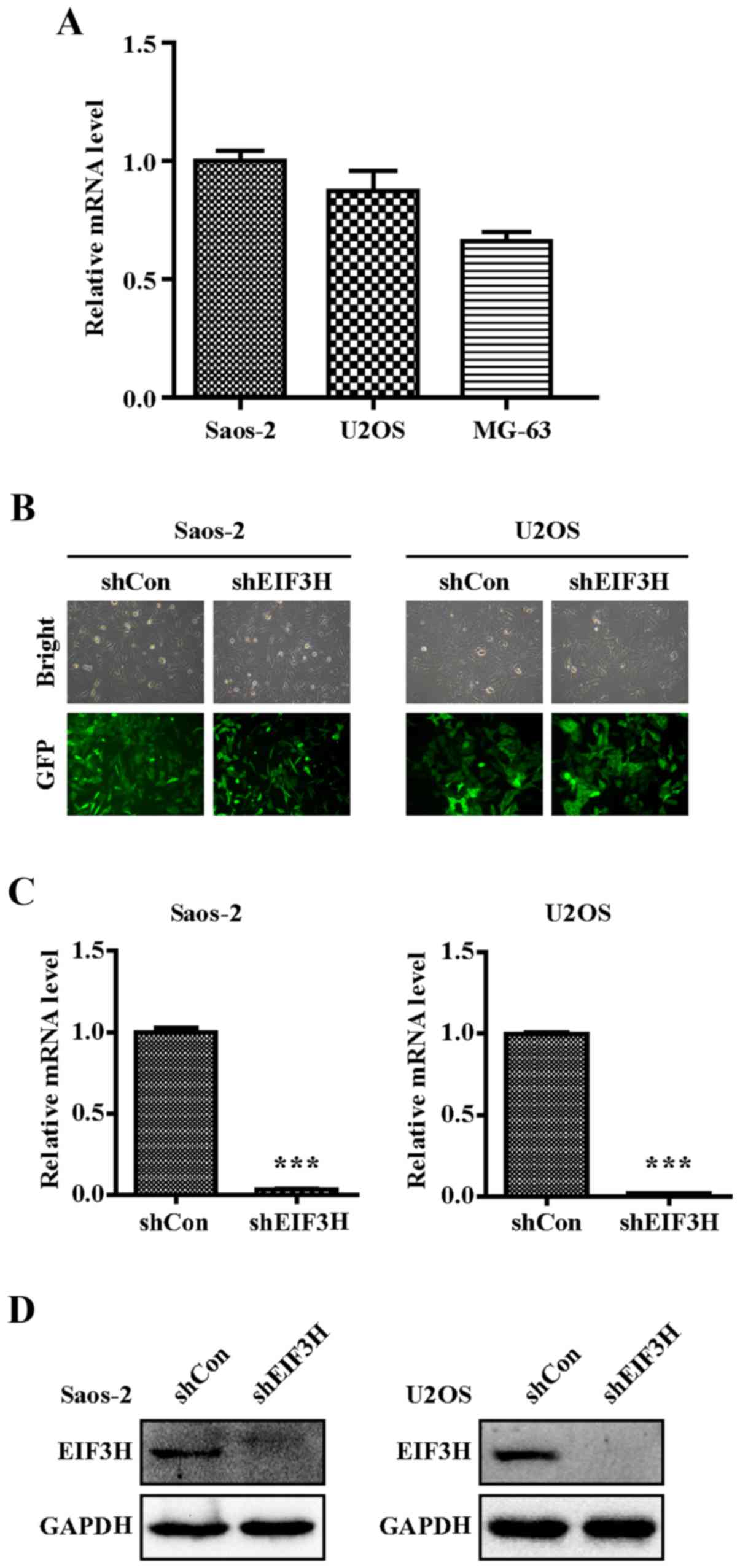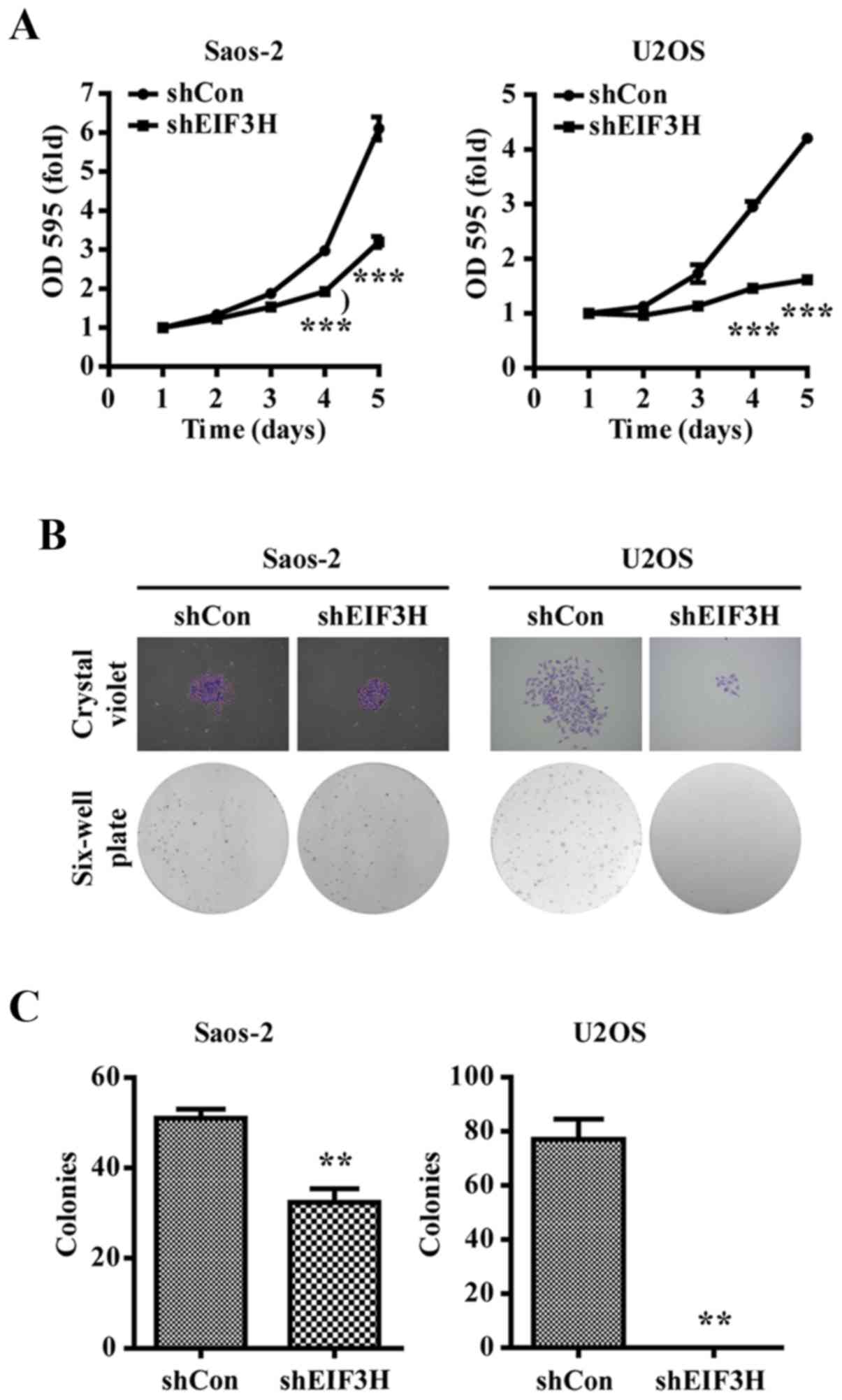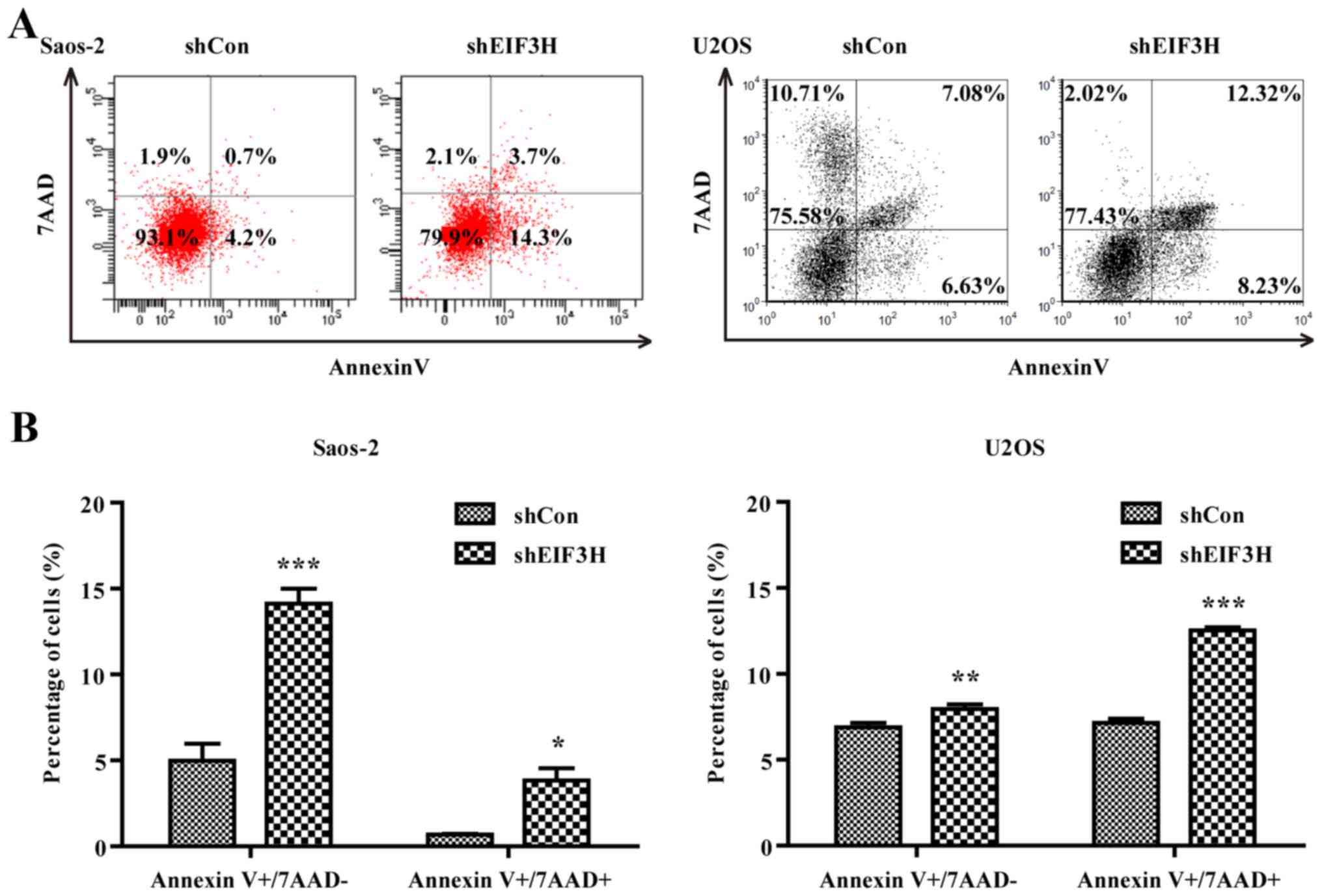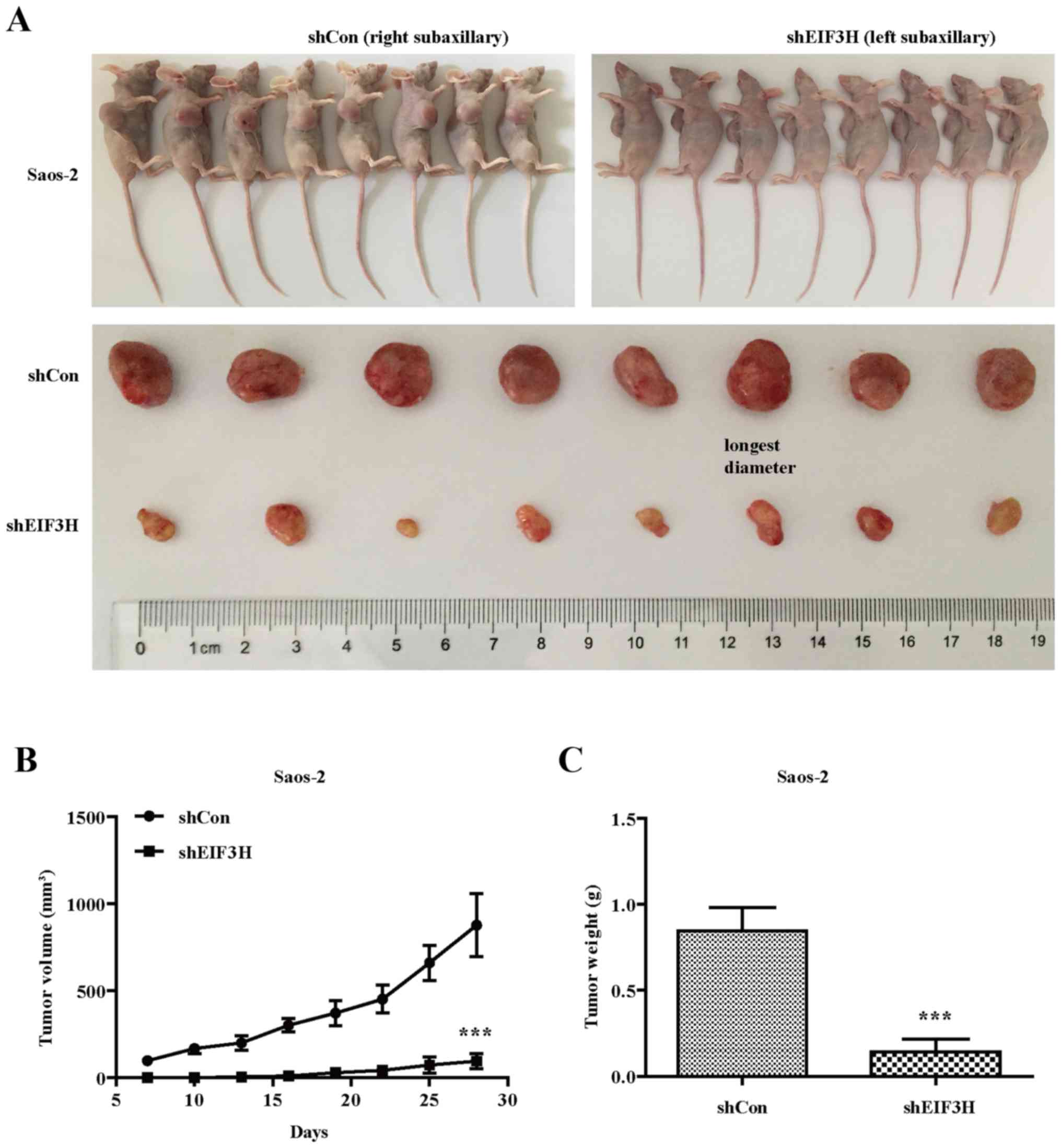|
1
|
Isakoff MS, Bielack SS, Meltzer P and
Gorlick R: Osteosarcoma: Current treatment and a collaborative
pathway to success. J Clin Oncol. 33:3029–3127. 2015. View Article : Google Scholar : PubMed/NCBI
|
|
2
|
Gill J, Ahluwalia MK, Geller D and Gorlick
R: New targets and approaches in osteosarcoma. Pharmacol Ther.
137:89–99. 2013. View Article : Google Scholar : PubMed/NCBI
|
|
3
|
Mirabello L, Troisi RJ and Savage SA:
Osteosarcoma incidence and survival rates from 1973 to 2004: Data
from the surveillance, epidemiology, and end results program.
Cancer. 115:1531–1543. 2009. View Article : Google Scholar : PubMed/NCBI
|
|
4
|
Masutani M, Sonenberg N, Yokoyama S and
Imataka H: Reconstitution reveals the functional core of mammalian
eIF3. EMBO J. 26:3373–3383. 2007. View Article : Google Scholar : PubMed/NCBI
|
|
5
|
Rooney PH, Murray GI, Stevenson DA, Haites
NE, Cassidy J and McLeod HL: Comparative genomic hybridization and
chromosomal instability in solid tumours. Br J Cancer. 80:862–873.
1999. View Article : Google Scholar : PubMed/NCBI
|
|
6
|
Nupponen NN, Kakkola L, Koivisto P and
Visakorpi T: Genetic alterations in hormone-refractory recurrent
prostate carcinomas. Am J Pathol. 153:141–148. 1998. View Article : Google Scholar : PubMed/NCBI
|
|
7
|
Mahmood SF, Gruel N, Chapeaublanc E,
Lescure A, Jones T, Reyal F, Vincent-Salomon A, Raynal V, Pierron
G, Perez F, et al: A siRNA screen identifies RAD21, EIF3H, CHRAC1
and TANC2 as driver genes within the 8q23, 8q24.3 and 17q23
amplicons in breast cancer with effects on cell growth, survival
and transformation. Carcinogenesis. 35:670–682. 2014. View Article : Google Scholar : PubMed/NCBI
|
|
8
|
Cappuzzo F, Varella-Garcia M, Rossi E,
Gajapathy S, Valente M, Drabkin H and Gemmill R: MYC and EIF3H
Coamplification significantly improve response and survival of
non-small cell lung cancer patients (NSCLC) treated with gefitinib.
J Thorac Oncol. 4:472–478. 2009. View Article : Google Scholar : PubMed/NCBI
|
|
9
|
Schefe JH, Lehmann KE, Buschmann IR, Unger
T and Funke-Kaiser H: Quantitative real-time RT-PCR data analysis:
Current concepts and the novel ‘gene expression's CT difference‘
formula. J Mol Med (Berl). 84:901–910. 2006. View Article : Google Scholar : PubMed/NCBI
|
|
10
|
Nupponen NN, Porkka K, Kakkola L, Tanner
M, Persson K, Borg A, Isola J and Visakorpi T: Amplification and
overexpression of p40 subunit of eukaryotic translation initiation
factor 3 in breast and prostate cancer. Am J Pathol. 154:1777–1783.
1999. View Article : Google Scholar : PubMed/NCBI
|
|
11
|
Daxinger L, Oey H, Apedaile A, Sutton J,
Ashe A and Whitelaw E: A forward genetic screen identifies
eukaryotic translation initiation factor 3, subunit H (eIF3h), as
an enhancer of variegation in the mouse. G3 (Bethesda).
2:1393–1396. 2012. View Article : Google Scholar : PubMed/NCBI
|
|
12
|
Zhu Q, Qiao GL, Zeng XC, Li Y, Yan JJ,
Duan R and Du ZY: Elevated expression of eukaryotic translation
initiation factor 3H is associated with proliferation, invasion and
tumorigenicity in human hepatocellular carcinoma. Oncotarget.
7:49888–49901. 2016.PubMed/NCBI
|
|
13
|
Savinainen KJ, Helenius MA, Lehtonen HJ
and Visakorpi T: Overexpression of EIFS3 promotes cancer cell
growth. Prostate. 66:1144–1150. 2006. View Article : Google Scholar : PubMed/NCBI
|
|
14
|
Zhang L, Smit-McBride Z, Pan X, Rheinhardt
J and Hershey JW: An oncogenic role for the phosphorylated
h-subunit of human translation initiation factor eIF3. J Biol Chem.
283:24047–24060. 2008. View Article : Google Scholar : PubMed/NCBI
|
|
15
|
Choudhuri A, Maitra U and Evans T:
Translation initiation factor eIF3h targets specific transcripts to
polysomes during embryogenesis. Proc Natl Acad Sci USA.
110:9818–9823. 2013. View Article : Google Scholar : PubMed/NCBI
|
|
16
|
Ingolia NT, Ghaemmaghami S, Newman JR and
Weissman JS: Genome-wide analysis in vivo of translation with
nucleotide resolution using ribosome profiling. Science.
324:218–223. 2009. View Article : Google Scholar : PubMed/NCBI
|
|
17
|
Roy B, Vaughn JN, Kim BH, Zhou F,
Gilchrist MA and Von Arnim AG: The h subunit of eIF3 promotes
reinitiation competence during translation of mRNAs harboring
upstream open reading frames. RNA. 16:748–761. 2010. View Article : Google Scholar : PubMed/NCBI
|
|
18
|
Spilka R, Ernst C, Mehta AK and Haybaeck
J: Eukaryotic translation initiation factors in cancer development
and progression. Cancer Lett. 340:9–21. 2013. View Article : Google Scholar : PubMed/NCBI
|
|
19
|
Graff JR and Zimmer SG: Translational
control and metastatic progression: Enhanced activity of the mRNA
cap-binding protein eIF-4E selectively enhances translation of
metastasis-related mRNAs. Clin Exp Metastasis. 20:265–273. 2003.
View Article : Google Scholar : PubMed/NCBI
|
|
20
|
Zimmer SG, DeBenedetti A and Graff JR:
Translational control of malignancy: The mRNA cap-binding protein,
eIF-4E, as a central regulator of tumor formation, growth, invasion
and metastasis. Anticancer Res. 20:1343–1351. 2000.PubMed/NCBI
|
|
21
|
Kim BH, Cai X, Vaughn JN and von Arnim AG:
On the functions of the h subunit of eukaryotic initiation factor 3
in late stages of translation initiation. Genome Biol. 8:R602007.
View Article : Google Scholar : PubMed/NCBI
|














